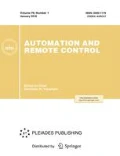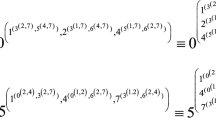Abstract
The paradigm of computations on the Petri nets was shown to appreciably speed up the computations and reduce laboriousness of software development owing to the mass parallelism and asynchronous information processing. A language of the programmed Petri nets was developed, alternative approaches to realizing the paradigm at the micro and macro levels were proposed, and the estimates of complexity of the earlier universal Petri net that are prototypes of the corresponding processor were specified. Indicated were the lines of practical realization of the paradigm such as the development of the technology of programming on the loaded Petri net, technology of translation of the loaded Petri nets to the inhibitory Petri nets, and the efficient hardware processors executing programs in the language of the inhibitory Petri nets. Fast computations are supported by the nets of the Sleptsov class with multiple start of transition at a step.
Similar content being viewed by others
References
Peterson, J.L., Petri Net Theory and Modeling of Systems, Englewood Cliffs: Prentice-Hall, 1981. Translated under the title Teoriya setei Petri i modelirovanie sistem, Moscow: Mir, 1984.
Kotov, V.E., Seti Petri (Petri Nets), Moscow: Nauka, 1984.
Sleptsov, A.I. and Yurasov, A.A., Avtomatizatsiya proektirovaniya upravlyayushchikh sistem gibkikh avtomatizirovannykh proizvodstv (Automated Design of the Control Systems for Flexible Computer-aided Manufacturing), Malinovskii, B.N., Ed., Kiev: Tekhnika, 1986.
Achasova, S.M. and Bandman, O.L., Korrektnost’ parallel’nykh vychislitel’nykh protsessov (Correctness of Parallel Computations), Novosibirsk: Nauka, 1990.
Jensen, K., Colored Petri Nets. Basic Concepts, Analysis Methods and Practical Use, 3 vols., New York: Springer, 1997.
Lomazova, I.A., Vlozhennye seti Petri: modelirovanie i analiz raspredelennykh sistem s ob”ektnoi strukturoi (Emberdded Petri Nets: Modeling and Analysis of Distributed Systems with Object Sturucture), Moscow: Nauchnyi Mir, 2004.
Zaitsev, D.A., Clans of Petri Nets: Verification of Protocols and Performance Evaluation of Networks, Saarbrücken: LAP LAMBERT Acad. Publishing, 2013.
Peng, S.S. and Zhou, M.Ch., Petri Net Based PLC Stage Programming for Discrete-event Control Design, in Systems, Man, and Cybernetics, 2001 IEEE Int. Conf., 2001, vol. 4, pp. 2706–2710.
Rossmann, J. and Eilers, K., Translating Robot Programming Language Flow Control into Petri Nets, in Emerging Technologies and Factory Automation (ETFA), 2011 IEEE 16th Conf. Digital Object Identifier, 2011, pp. 1–7.
Palomeras, N., Ridao, P., Carreras, M., et al., Using Petri Nets to Specify and Execute Missions for Autonomous Underwater Vehicles, in Intelligent Robots and Systems, IROS 2009, IEEE/RSJ Int. Conf., Oct. 10–15, 2009, pp. 4439–4444.
Dodd, R.B., Coloured Petri Net Modelling of a Generic Avionics Mission Computer, Air Operations Division: Defence Science and Technology Organisation, Australia, DSTO-TN-0692, 2006.
Usher, M. and Jackson, D., A Petri Net Based Visual Programming Language, in Systems, Man, and Cybernetics, 1998. IEEE Int. Conf., 1998, vol. 1, pp. 107–112.
Iordache, M.V. and Antsaklis, P.J., Petri Nets and Programming: A Survey, in Am. Control Conf. 2009, ACC’09, 2009, pp. 4994–4999.
Voevodin, V.V. and Voevodin, Vl.V., Parallel’nye vychisleniya (Parallel Computations) St. Petersburg: BKnV-Peterburg, 2002.
Zaitsev, D.A., Universal Petri Net, Kibern. Sist. Anal., 2012, no. 4, pp. 24–39.
Zaitsev, D.A., Toward the Minimal Universal Petri Net, IEEE Trans. Syst., Man, Cybernet., 2014, vol. 44, no. 1, pp. 47–58.
Zaitsev, D.A., Inhibitory Petri Net Executing an Arbitrary Defined Turing Machine, Sist. Doslidzh. Inform. Tekhnol., 2012, no. 2, pp. 26–41.
Zaitsev, D.A., Inhibitory Petri Net Executing an Arbitrary Defined Normal Markov Algorithm, Modelir. Anal. Inform. Sist., 2011, vol. 18, no. 4, pp. 80–93.
Sleptsov, A.I., State Equations and Equivalent Transformations of Loaded Petri Nets (Algebraic Approach), in Formal Models of Parallel Computation, Proc. All-Union Conf., Novosibirsk, 1988, pp. 151–158.
Zaitsev, D.A. and Sleptsov, A.I., State Equation and Equivalent Transformations of the Time Petri Nets, Kibern. Sist. Anal., 1997, no. 5, pp. 59–76.
Zaitsev, D.A., Small Polynomial Time Universal Petri Nets, arXiv:1309.7288.
Author information
Authors and Affiliations
Corresponding author
Additional information
Original Russian Text © D.A. Zaitsev, 2014, published in Avtomatika i Telemekhanika, 2014, No. 8, pp. 19–36.
Rights and permissions
About this article
Cite this article
Zaitsev, D.A. Paradigm of computations on the Petri nets. Autom Remote Control 75, 1369–1383 (2014). https://doi.org/10.1134/S0005117914080025
Received:
Published:
Issue Date:
DOI: https://doi.org/10.1134/S0005117914080025




